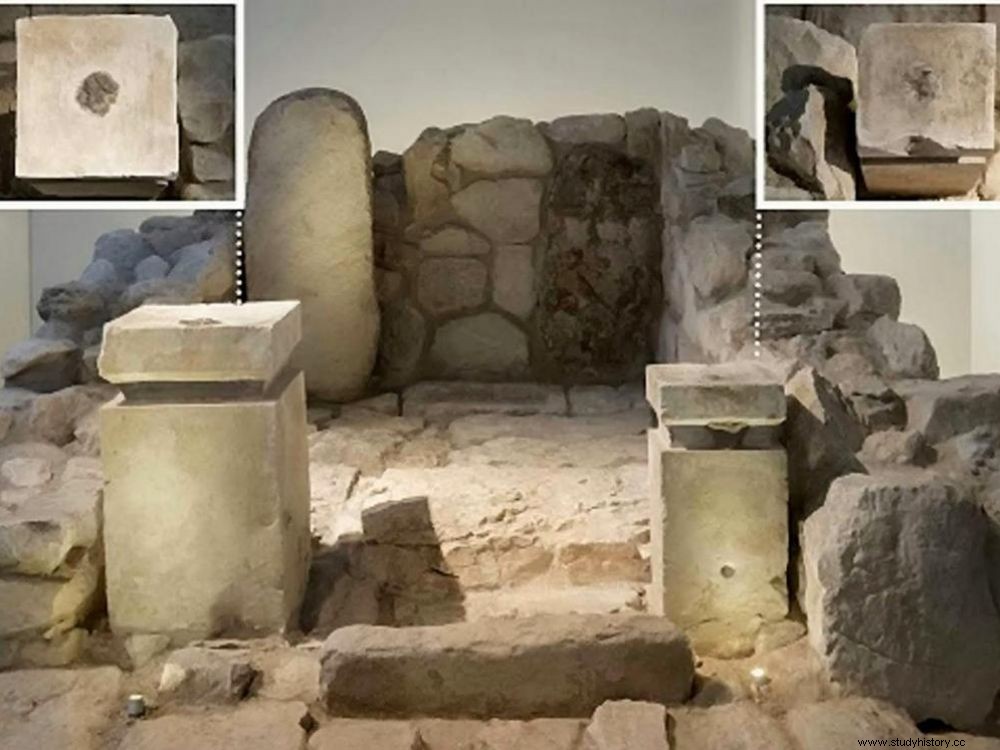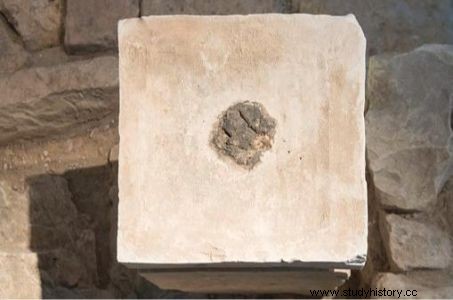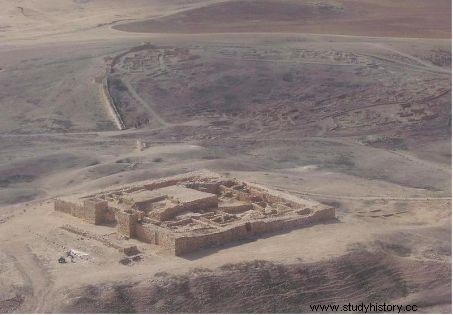Chemical analysis of residues preserved in an ancient Iron Age fortress in Tel Arad, in the Negev desert (Israel), revealed the unexpected presence of cannabis! The first evidence of a use of this psychotropic in the ancient Near East.

The "holy of holies" of the sanctuary of the ancient Iron Age fortress of Tel Arad (Israel), and its two altars.
Unprecedented, the discovery could even be described as... mind-blowing. Residues of cannabis, on one side, and incense, on the other, were discovered on two altars placed at the entrance of an ancient Iron Age sanctuary used between 760 and 715 BC. AD, in the fortress of Tel Erad (Israel). The imposing military bastion, located west of the Dead Sea in the Beer-Sheba Valley, then served to guard the southern border of the Kingdom of Judah, which today corresponds to the center of Israel and part of the West Bank. Excavated in the 1960s, the precious shrine was then dismantled and transported to the Jerusalem Museum, where it is now on display.
On a small altar, cannabinoid residue
The analysis of the surface of the two altars carved in limestone has just been the subject of a detailed publication in the online magazine "Tel Aviv" , published by the Institute of Archeology at Tel Aviv University. Two small depressions on each of the pillars have indeed preserved for nearly 2800 years the remains of solidified blackish organic matter that the researchers have managed to identify thanks to an analysis by gas and liquid phase chromatography, coupled with mass spectrometers. And the results were amazing!

Upper part of one of the altars of the sanctuary of Tel Arad (Israel), with residues of organic matter in the center. ©Israel Antiquities Authority Collection / The Israel Museum, Jerusalem, by Laura Lachman
The larger of the two altars contained incense mixed with animal fats which, on heating, released the fragrance of the resin; as for the small altar, it contained residues of cannabinoids:teterahydrocannabinol (THC), cannabidiol (CBD) and cannabinol (CBN).
Unprecedented, the discovery could even be described as... mind-blowing. Residues of cannabis, on one side, and incense, on the other, were discovered on two altars placed at the entrance of an ancient Iron Age sanctuary used between 760 and 715 BC. AD, in the fortress of Tel Arad (Israel). The imposing military bastion, located west of the Dead Sea in the Beer-Sheba Valley, then served to guard the southern border of the Kingdom of Judah, which today corresponds to the center of Israel and part of the West Bank. Excavated in the 1960s, the precious shrine was then dismantled and transported to the Jerusalem Museum, where it is now on display.
On a small altar, cannabinoid residue
The analysis of the surface of the two altars carved in limestone has just been the subject of a detailed publication in the online magazine "Tel Aviv" , published by the Institute of Archeology at Tel Aviv University. Two small depressions on each of the pillars have indeed preserved for nearly 2800 years the remains of solidified blackish organic matter that the researchers have managed to identify thanks to an analysis by gas and liquid phase chromatography, coupled with mass spectrometers. And the results were amazing!

Upper part of one of the altars of the sanctuary of Tel Arad (Israel), with residues of organic matter in the center. ©Israel Antiquities Authority Collection / The Israel Museum, Jerusalem, by Laura Lachman
The larger of the two altars contained incense mixed with animal fats which, on heating, released the fragrance of the resin; as for the small altar, it contained residues of cannabinoids:teterahydrocannabinol (THC), cannabidiol (CBD) and cannabinol (CBN). The cannabis had been mixed with animal waste used as fuel, to release the psychoactive compounds via heat. "If we knew that incense played a special role in the religious rituals practiced in the kingdom of Judah in the 1 st millennium before our era, it had never been discovered until then on a site in the Levant. As for cannabis, this is the first time that we have found traces of it!, explain Eyrane Arié, chief curator of the Department of Archeology of the Iron Age and Persian periods at the Israel Museum in Jerusalem, and Dvory Namdar, researcher at the Volcani Institute for Agricultural Research, the two main co-signatories of the study joined by Sciences et Avenir. These finds may suggest that cannabis inflorescences were burned to be inhaled as part of a ritual ceremony. In the sample examined, the quantity of psychoactive compounds was sufficient to have induced an altered state of consciousness."

Aerial view of the fortress of Tel Arad, in the Negev desert (Israel). ©Wikimedia commons
"Plants were being grown around the same time in what is now China"
The supposed use of hallucinogenic substances in the context of cultic ceremonies, to promote a kind of ecstasy, sheds new light on the religious practices of the 8 e century BC in the kingdom of Judah. "It is indeed not excluded that cannabis could also have been used in other sanctuaries and temples of the kingdom of Judah, including the great Temple of Jerusalem , adds Eyrane Arie. Plants were being grown around the same time in what is now China. Seeds and leaves of Cannabis Sativa L.were recently collected from tombs in the Gobi Desert, at Yanghai, near Turpan, as well as in Jirzankal, east of the Pamirs." Over the centuries, the products of this plant, native to the foothills of the Himalayas and the Tibetan plateau, have been transported in the form of hashish resin following the trade routes from Central and Eastern Asia to the Near East. .
As for frankincense - an aromatic incense made from Boswellia resin - Its use is well mentioned in the Bible, just like that of myrrh, another fragrant resin. But it had never yet been found on an archaeological site in the Levant. "In the Iron Age, these products probably reached the Middle East, via trade with the southern Arabian Peninsula (present-day Yemen and southern Saudi Arabia)which reveals high-cost imports" , continues the archaeologist. In the Bible, the value of frankincense, described as a royal treasure, is indeed often compared to that of gold.
Other amalgamated residues have been spotted on two other altars discovered in the ancient kingdom of Moab (now in Jordan). Their upcoming analysis may provide new insights into the use of these mind-altering substances in the ancient Near East, of which Tel Arad today provides the first evidence of hallucinogenic use.
